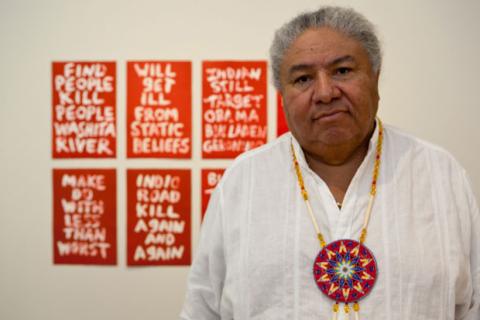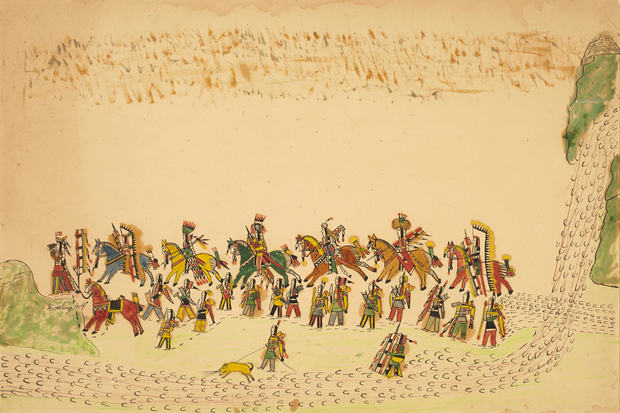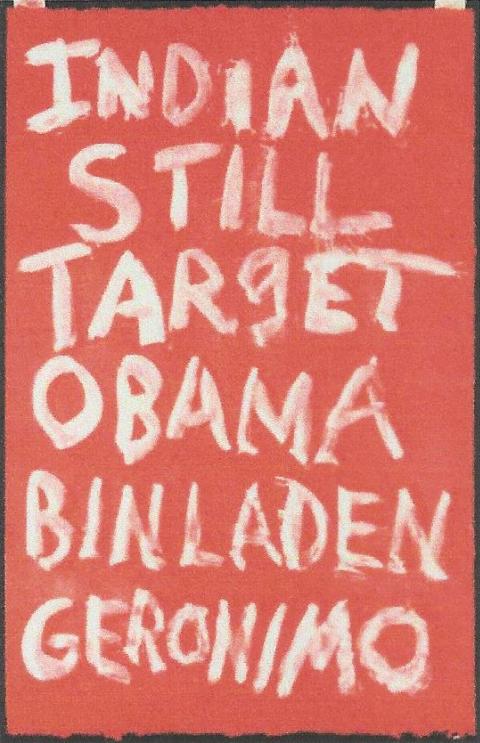 |
Canku Ota
|
 |
|
(Many Paths)
|
||
|
An Online Newsletter
Celebrating Native America
|
||
|
March 2016 - Volume
14 Number 3
|
||
|
|
||
|
Artist, Educator
And Soldier Edgar Heap Of Birds On "Dead Indian Stories"
|
||
|
by Scott Wheldon - Cheyenne
& Arapaho Tribal Tribune
|
||
|
In Honolulu for a conference, the artist graciously visited
the museum to give a talk on Jan. 6 to a select group of museum
supporters. Hearing him tell the story about the connection between
his prints and Howling Wolf's painting was a moving experience.
Edgar took the time to answer some questions about the two. Can you talk about the origin of 'Dead Indian Stories,' and
about the meaning behind the prints? It goes back to Howling Wolf's work. It was done while he was
incarcerated in Ft. Marion (Florida, in the late 1800s). He was
a part of the Bowstring Warriors Society, and I'm a leader of the
Elk Warriors Society. The Bowstring and the Elk share the same tipi,
so in 1870 my great-great-grandfather would have been in the tipi
with him. Howling Wolf's father, Eagle Head, and a man named Many Magpies, which later translated to Heap o Birds, then later Heap of Birds, were two of the principle chiefs of the Cheyenne tribe. The other two principle chiefs in the paintings are named Star and Gray Beard. After the Washita massacre of 1868 they were incarcerated as a penalty for fighting against the colonial genocide, and Gray Beard was killed by U.S. soldiers en route to Florida.
My Cheyenne name is Little Chief, a name I inherited from my
uncle Edgar, who inherited it from the first Little Chief, Heap
of Birds' nephew, who was also a Warriors Society member imprisoned
in Florida. The first Little Chief would have been Howling Wolf's
contemporary. The fact that Howling Wolf's drawing is here is amazing.
It shows that while other Warriors Society members died in incarceration,
Howling Wolf survived it. Today when I lecture about Ft. Marion I draw a comparison with
Guantanamo Bay, a space where you have so-called "enemy combatants"
who are sequestered without charges or trial. They can take you
away from your families and your community, then hold your family
hostage in a sense; if they didn't abide by America's rules, the
government might execute the warriors. Abraham Lincoln, for example,
hung 38 warriors himself, Andrew Johnson hung two more. It was a
way for them to keep the tribe "in line," to separate the warriors
from their families, knowing that the warriors might never come
back. When Oklahoma was becoming a state they built three forts, Ft.
Reno, named for Captain Reno, who fought with Custer; Ft. Cantonment;
and Ft. Supply, which was meant to resupply Custer from Ft. Hays
and Ft. Leavenworth in Kansas, so he could come massacre the tribe
at the Washita River. These three forts were built to contain the
tribe, so I say in kind of a satirical way that we were never safe.
For example, if you were in Afghanistan, the forts were not good
for you, as an Afghani. We think of forts as being a good thing,
but it depends on what side of the fort you're on. These were pretty
brutal outposts, the army comes and attacks and murders Native peoples
before the settlers come and create a so-called settlement. My work often deals with political trauma and tragedy that created
America. On the label I wrote about the Statue of Liberty, which
is seen as this symbol of welcoming, but if invited people to share
your house, you wouldn't think that's a good gesture. Everyone is
oblivious to that posture, that you're welcoming everyone to this
country, but it's not your country to welcome anyone to. America
murdered the people that were there. To bring it forward to contemporary time, "INDIAN STILL TARGET
OBAMA BIN LADEN GERONIMO," refers to the fact that the government
referred to Bin Laden as Geronimo. So when they killed him, Obama
said, 'Geronimo is dead,' and everyone cheered. Here we are in contemporary
life and they choose to nickname a hated terrorist an Apache name.
Are we still targets? What about the 'Apache Helicopter' and the
'Tomahawk Rocket?' All these things are so violent, why are they
associated with native people? "INDIO ROAD KILL AGAIN AND AGAIN," goes back to a ceremonial
leader in my tribe whose son was killed in a car wreck by non-Native
people. They ran over his body so many times that they couldn't
put him in a casket, it was pulverized. He was just walking back
to his home, and many Natives die that way on the reservation, just
walking home and getting killed by cars. All of these works are very personal, about the grief and trauma shared by members of the tribe, and the Warriors Society. On the other side of the coin, I'm a professor at the University of Oklahoma, a mentor, an academic, a professional, an artist and a soldier, which I probably take as my most important role, a soldier to protect the tribe. But in the tribe a soldier's responsibility is also the religion. Lately when I'm at gatherings of the whole tribe, they ask me to pray for everybody. I'm just a soldier sitting in the back. I'd rather just sit back, relax and have my dinner, but they call me to the front and say, 'You need to pray for all the people.' I've become an elder, and now that's part of what I do, and I'm proud to do it. Part of that is making art, but you can't just make art about being a happy person, there has to be a testimony about the reality.
Yes, to inform. It's not so much as an assault, it's more for
protection. Art is a cultural apparatus. Take Howling Wolf's drawing,
he was a warrior, his family was hunted and killed in the Washita
massacre, but he wanted to go home. He's not going to make drawings
about killing white people. His job is to protect the tribe and
kill Custer, which they did at Little Big Horn. But while he was
in prison, he couldn't make that drawing of killing Custer. If you
make a drawing of you killing your jailor, you'll never get parole.
Some of the work has become a fiction that a non-Native person would
want to buy. A non-Native person gave him the materials, a non-Native
person, Captain Pratt, was his jailor. Eventually they decided,
'Okay he's rehabilitated, send him back The sad part about that is that this kind of art about the 'good
Indian' doing pastoral work has become a genre. Ledger drawing then
became the birth of Native American art patronage in America and
continues to this day, where by the content of Native art was/is
dictated by non-Natives. It's a way for Native artists to fit into
society and make money. However this sort of self-censorship does
a disservice because the white American public has no clue about
the dysfunction, suicide, teen pregnancy and illiteracy because
all they see are these nice paintings they want to buy. The trading posts and galleries for Native art take 50 percent
of the sales of these pastoral works, thus Native art has been a
profitable business for non-Natives. I have to sort of fight that.
We've been co-opted by this industry, it's about their apparatus
of money making, not the reality of what's happening culturally.
It's difficult to reveal the reality of the damage and all the problems
of tribal life in America, when people see art like this and say,
'Well look here. There's no violence here. All of the lovely baskets
in Santa Fe, Scottsdale, Sedona, don't show this kind of violence,
why did you make that?' Did you know that Howling Wolf's painting was here before
bringing your installation to the museum? No, I didn't know. Jay Jensen, curator of contemporary art had
told me about it and it's amazing that it's here. I'm really proud
to be exhibiting with it. As I said to Jay, there are four chiefs
here, along with Howling Wolf. One of these four chiefs would have
been my great-great-grandfather Heap of Birds. With this painting
Howling Wolf is surviving, fighting a different kind of fight, and
I'm doing these gestures to his prints. I don't fault Howling Wolf for doing this kind of work. My father
was an aircraft factory worker. He raised six kids, and worked three
jobs so that I could go out and make this and be in the leadership
ceremony. I don't fault what the older men had to do to allow me
to survive and take breath. I understood some of the prints only when you explained them.
Others are immediately understandable, like "HAPPY TO DONATE WHAT
YOU TOOK." How do you decide how explicit your message is? The artist's material does a little bit of that, but I write
this way because I hope that people can interpret the work with
their own ideas. I want the work to join forces with the viewers'
imaginations. I have a lot of respect for the viewer, so the work
doesn't need to be didactic. I know about a boy who got killed in San Francisco by a bus,
and I'm sure that when his parents saw "INDIO ROAD KILL AGAIN AND
AGAIN" they were thinking about their son who died in San Francisco.
There are other ways for people to relate to the work, which brings
us back to not thinking about the idea of being Native as being
a disadvantage story or a pastoral story, but a human story. We
should all have a way to enter the work. By leaving it somewhat ambiguous I'm leaving the door cracked
open. If I made it too explicit, you could just digest it and eject
it, you don't have to really consider it. I hope that people look
at the work, and when they enter it they can relate it to themselves. I also believe in a fragmentary experience where you can carry
some of this with you, and then tomorrow, or next week, or next
month, something might happen to you that makes you think of this
work. It's not a capsule in which there is one narrative pill, it's
more of a fragmentary experience that people can have. That's why
the prints are made in this mysterious method. These are all done
on Plexiglas, they're all made singularly and I'm painting backwards
on clear glass, which are then printed up. It doesn't look quite
so clear, like the meanings of each work might not be so clear. Except for "HAPPY TO DONATE WHAT YOU TOOK," which Jay requested,
how did you decide on what prints to use for this installation? I thought these works were compatible with each other. I usually
do installations of 16 prints, but I always do it in multiples of
four. Four is a very important ceremonial number for the Cheyenne,
it relates to the solstice and equinox of the earth. On being deliberate with numbers, is there a reason why you
have chosen to have six words on each print? It has become a trait of mine, it's somewhat mysterious. I go
back and think of my name, Heap of Birds, that has a certain cadence
that I've been living with all my life. Looking at each of these
prints, like "WILL GET ILL FROM STATIC BELIEFS" or "INDIO ROAD KILL
AGAIN AND AGAIN," I think of these messages as being made up of
two sets of three words. As a young artist I was on the east coast, and I was in New
York all the time. At that time, from '75 to '81, The Talking Heads
were big. We were all disciples of The Talking Heads. Stop Making
Sense, and Fear of Music, all these things that David Byrne did
I really liked a lot. I probably ended up inheriting some of his
rhythm. I am really an artist that was reared in New York and the
contemporary art of the 80s. I was in the middle of a lot of social
discourse of that time. What other artists, contemporary or otherwise, would you
say influenced your work? The biggest one for me when I was a young guy was the performance
artist Vito Acconci. He gave a talk at my school when I was getting
my masters degree in Philadelphia, and I've since showed with him.
In Wichita, Kan., Blackbear Bosin, a Comanche-Kiowa painter, was
my mentor. He was great to have as a mentor, he showed me how to
be an artist. We did an Instagram post about your installation, which generated
positive comments from people across the country who had either
taken a class from you or have heard you speak. It seems like you
have a wide reach as an educator. Is education a big priority in
your professional life? Yes, and you know I don't have a gallery. I've never had one, but as one of my colleagues told me I probably couldn't have had as big of an educational reach as I've had if I had a gallery. At this point of my career I would wish to be represented by a gallery, but my mission is to communicate, not to sell, and education is the best way to communicate.
Edgar
Heap of Birds Edgar
Heap of Birds | Brett Graham | Enrique Chagoya |
||
|
|
|
|
||
|
|
||
| Canku Ota is a free Newsletter celebrating Native America, its traditions and accomplishments . We do not provide subscriber or visitor names to anyone. Some articles presented in Canku Ota may contain copyright material. We have received appropriate permissions for republishing any articles. Material appearing here is distributed without profit or monetary gain to those who have expressed an interest. This is in accordance with Title 17 U.S.C. Section 107. | ||
|
Canku Ota is a copyright ©
2000 - 2016 of Vicki Williams Barry and Paul Barry.
|
||
 |
 |
|
|
The "Canku
Ota - A Newsletter Celebrating Native America" web site and
its design is the
|
||
|
Copyright ©
1999 - 2016 of Paul C. Barry.
|
||
|
All Rights Reserved.
|
||
 Now
on view in the gallery of the Arts of the Americas is a print series
by Oklahoma-based artist Edgar Heap of Birds. The text-based works
are a scathing indictment of crimes committed against Native Americans
and hang next the museum's mid to late 1870s painting by Cheyenne
warrior Howling Wolf, who became a proficient artist in the Ledger
style while imprisoned in Ft. Marion, Florida, in 1875.
Now
on view in the gallery of the Arts of the Americas is a print series
by Oklahoma-based artist Edgar Heap of Birds. The text-based works
are a scathing indictment of crimes committed against Native Americans
and hang next the museum's mid to late 1870s painting by Cheyenne
warrior Howling Wolf, who became a proficient artist in the Ledger
style while imprisoned in Ft. Marion, Florida, in 1875.
 I
read that you once said, "Native peoples have chosen art as their
cultural tool and weapon." As a soldier, do you consider these prints
your weapon?
I
read that you once said, "Native peoples have chosen art as their
cultural tool and weapon." As a soldier, do you consider these prints
your weapon?